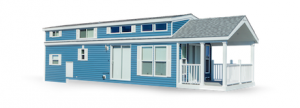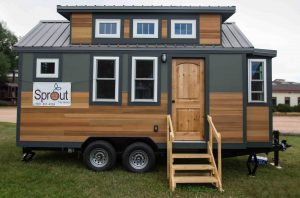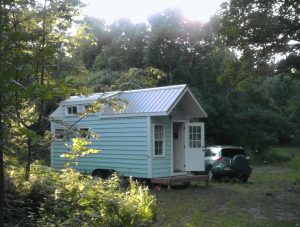There’s much talk about the tiny house and how it relates to other types of small manufactured homes.
It can get confusing, we’ve found, to compare and contrast tiny homes versus the park model home, for instance… particularly when you learn that definitions change with how the sun shines, and something to do, too, with grandma’s meatloaf.
Seriously, stick with us here.
Park Model Homes
What are park model rv’s? A brief but accurate way to describe park models is – a regulated temporary living space designed for an RV park setting:
- 399 or fewer square feet of living space (Fla. is 499 sf)
- Can be towed on public byways
- No mortgage available
- Requires registration, tags and insurance like a vehicle
- Ideal for RV park or blended RV/mobile home park
- Purchase from maker for ease of registration, travel safety
- Retail from $20,000 to $140,000 higher end
In the market? Check out our latest guide with tips and need-to-knows for purchasing a park model.
Curt Yoder is co-owner of Kropf Industries Inc., a Goshen, Ind. company that makes Park Models.


“What we sell is destination camping,” Yoder said. “We do not promote our units in any way to be lived in. We’re strictly recreational use.”
On the other hand, tiny houses are primarily seen as residences, even if second residences or guest houses, and are less-so regarded as a getaway property, like the RV or Park Home.
Nonetheless, the problem with tiny homes as a primary residence is that many local ordinances and codes prohibit certain sizes and residential placement. If allowed, they’re typically permitted as an accessory dwelling unit (ADU) for the rear or side of a property.
A tiny house on rural land most often is less challenging, but requirements exist in all but the rarest scenario.
“This makes some of the tiny home builders want to register as an RV, but then they want to say it’s lived in rather than seasonal, and that becomes the ticking point,” Yoder said.
“Similarly, over the years, we’ve had manufactured home dealers want to sell park models,” he added. “You’re trying to sell a home next to a recreational vehicle, and it doesn’t work out that well.”
Tiny House
A lifestyle concept embodied by a small home that can fit an MH community:
- 400 to 999 square feet of livable indoor floor space
- Some can be smaller dependent on siting and local regulations
- Anything smaller than 200 square feet is a shed
- Larger tiny home dimensions cannot be towed for recreation on public spaces
- Larger units can be hauled, if permitting and consumer/public protection is in place
- If on permanent foundation, can be primary residence
- Difficult to finance with mortgage loan, but possible
- No vehicle registration, tags or insurance
- Can be insured as personal property (chattel)
- Ideal for private land, back property guest home
- With the skills, you can build it yourself
- Cost differs on preference, from $8,000 self-built to the luxurious limit (Think Italian marble everywhere)


Shawn Fuller is sales manager at Tiny House Outlet, a division of Legacy Housing.
“Our tiny house stuff has just run away. It’s insane. I’ve never been on a wave like I’ve got surging now,” Fuller said.
Given that, Fuller has several models of tiny homes, and has developed an app that allows a customer to choose features and specifications, get financing, and have the home delivered all on the handheld device.
“There’s a lot of misinformation about tiny homes,” Fuller said. “A true tiny home has to be less than 399 square feet. If it’s bigger, you trigger all the federal guidelines on home construction. The biggest difference between a tiny home and true park model… I don’t know any park model manufacturer that’s not building to ANSI code.
“The only manufacturer I know of that’s building a tiny home with no code is Legacy, and that’s our product out of Commerce, Texas,” Fuller said.


What’s more
Therefore, the dividing line in an odd way – because it works in both directions – is 400 square feet. In this sense, the definitions change as much with the square feet as how the home is used and where it’s placed.
Therefore, the “on wheels” consideration for tiny homes is a big divider – a tiny home on wheels (THOW) is typically going to be 399 square feet or less, sometimes much less.
“A stick-built building on the proper heavy trailer larger than 8-foot wide by 16-foot long and 13 1/2-foot high will require a one-ton truck for towing,” Isa Bauer, owner of Tiny House Northeast, said. “You’re talking about a group of people who want to live in this home year-round for the sake of a smaller carbon footprint, and that doesn’t fit well if you’re using a giant truck to haul the home.”


If a tiny home is fewer than 200 square feet and stays put, which many are, a predominant number of municipalities and other local governments will consider the structure a shed, and therefore unregulated.
This is the backyard grandma house, the meditation hut, the art center, the kid playhouse. You can plug in a TV, radio or computer, run a small AC or heater, and have a desk and bed, but likely will be without plumbing and running water.
The Final Word
Back to the direction of sun and grandma’s meatloaf.
Didn’t think we’d forget, did you?
Yes, Yoder said his designers, builders and inspectors subscribe to what he calls the “only true way to measure a park model”.
“When sun is at high noon, anything that casts a shadow off the home, including overhang and what else, is measured, and those are your dimensions,” Yoder said.
And Fuller, in comparing his tiny homes to the industry – It’s a matter of giving the customer what they want… Price point and a level of quality.
“The start of the whole tiny home thing was like grandma’s meatloaf,” Fuller said. “You don’t know what’s in it, but we know it’s good. We love to eat it. My tiny homes are like the Cracker Barrel meatloaf. It’s good, and we like to eat it, but it’s not really like grandma’s.
“Not everyone can get grandma’s meatloaf,” Fuller said.
“Grandma’s meatloaf” tiny home is available from Fuller at $25,000. The Kropf Island Series Park Model is available for $54,000, depending on the retail outlet, and the “Weelhouse” from Tiny House Northeast is $35,000.














